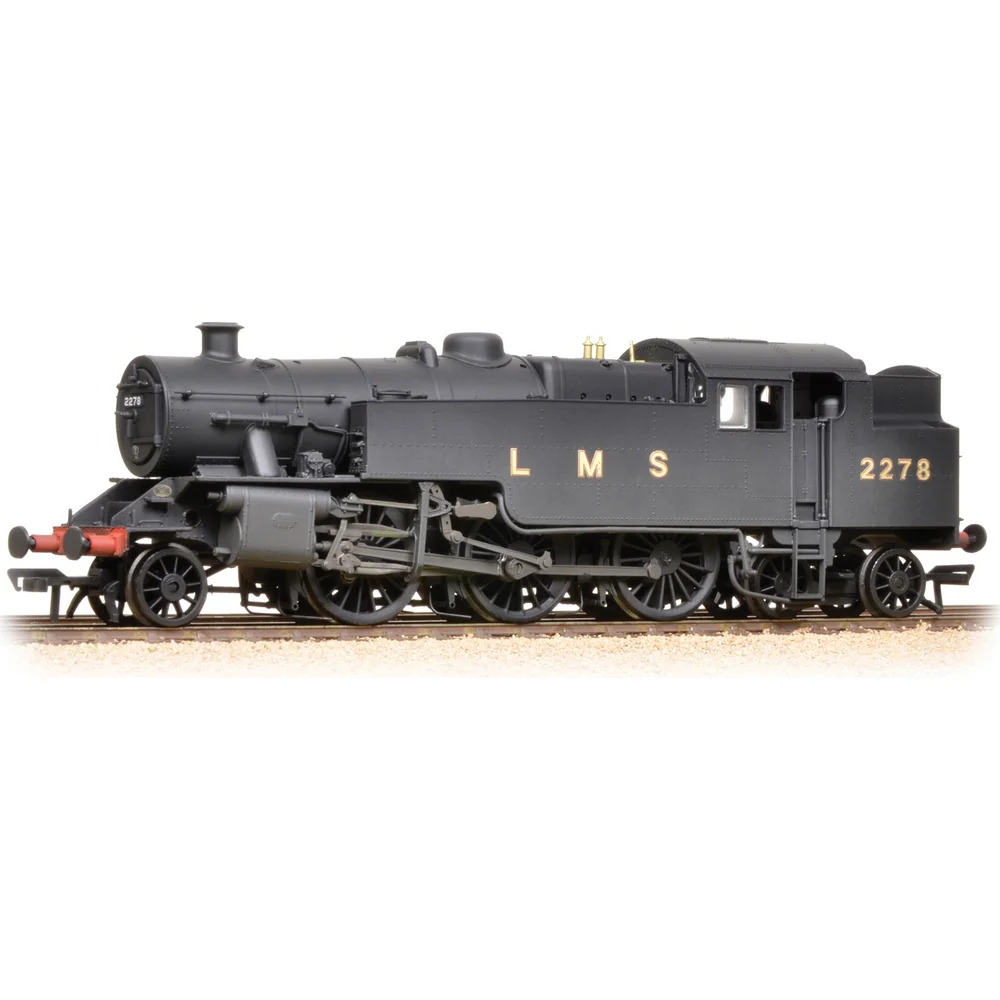Bachmann 32-880
London, Midland & Scottish Railway Fairburn 2-6-4T 2278 London, Midland & Scottish Railway Black
Tooling
Bachmann introduced its OO gauge model of the LMS Fairburn 2-6-4T tank locomotive in the mid-2000s, with the first notable release appearing in 2006. This tooling represented a significant step forward in detail and performance compared to earlier steam models, offering accurate proportions and modern features for both collectors and operators. The prototype was designed by Charles Fairburn for the LMS in the 1940s and later adopted by British Railways, making it a popular subject for modelers of LMS and BR eras.
Tooling Features
- Scale: OO gauge (1:76), designed for LMS and BR liveries across Eras 3–5.
- Construction: Die-cast chassis for weight and traction, plastic bodyshell with fine rivet detail, separately fitted handrails and pipework.
- Detailing: Sprung buffers, turned brass safety valves, lamp irons, and vacuum pipes supplied in an accessory pack.
- Couplings: NEM pockets with tension-lock couplers fitted as standard.
Mechanical & Electrical
- Motor & Drive: Powerful 3-pole motor with all-wheel drive and pickup for smooth running.
- Minimum Radius: Recommended second radius (approx. 18 inches).
- Weighting: Die-cast chassis provides good adhesion and stability.
- Lighting: No factory-fitted lighting on this tooling.
DCC Capability
The model is DCC-ready with an 8-pin NEM652 socket located in the smokebox. A blanking plug is supplied for DC operation. Decoder installation requires removal of the body shell, which is secured by screws at the front and rear of the baseplate.
Liveries Produced
The initial releases included LMS black and a Collectors Club limited edition in Caledonian blue. Subsequent production runs featured BR lined black with early and late crests, plus weathered variants.
Reviews & Commentary
Upon release, the model was praised for its accurate proportions, robust mechanical performance, and ease of decoder installation compared to earlier Bachmann steam locomotives. Reviewers highlighted the fine detailing and smooth running qualities, making it a benchmark for mid-2000s OO gauge steam models.
Media & Social Media
Enthusiasts on forums and social platforms noted the model’s reliability and strong pulling power. While some commented that cab detail was basic compared to later standards, overall reception was positive, and the tooling remained popular until superseded by Bachmann’s later “Blue Riband” specification models.
Interesting Facts
- The Fairburn 2-6-4T was a key LMS design that influenced later BR Standard tank locomotives.
- Bachmann’s 2006 tooling included a comprehensive spares list, making maintenance straightforward for long-term owners.
Class & Prototype
- Class: London, Midland & Scottish Railway Fairburn 2-6-4T
- Traction: Steam
- Built: 1945-1951
- Total Built: 277
- Running Number: 2278
Operator & Livery
- Operator: London, Midland & Scottish Railway
- Livery: Black
- Era: 3 - The big 4 – LMS, GWR, LNER & SR
The London, Midland & Scottish Railway (LMS) was Britain's largest railway company from 1923-1948, formed by merging over 120 independent railways under the Railways Act 1921. Operating 7,790 route miles across England, Scotland, Wales, and Northern Ireland, the LMS became the world's largest transport organisation and the British Empire's biggest commercial enterprise. Famous for iconic locomotives like the streamlined Princess Coronation class, versatile Black Fives, and Royal Scots, the company evolved from inherited pre-grouping designs to revolutionary Stanier innovations. The LMS operated major routes including the West Coast Main Line from London Euston to Scotland, serving as the UK's second-largest employer after the Post Office. Nationalised in 1948 to form British Railways' London Midland Region, the LMS legacy continues through extensive preservation efforts and remains a favourite subject for railway modellers seeking authentic British steam-age prototypes.
The LMS plain black livery served as the standard finish for freight locomotives and represented practical railway economics during the company's existence. Applied without lining or embellishment, this utilitarian scheme recognised that goods engines operated in inherently dirty conditions where elaborate paintwork proved both expensive and impractical.
Most LMS freight classes including the ubiquitous 0-6-0 goods engines, 0-8-0 heavy freight locomotives, and tank engines used for shunting duties wore plain black throughout their service lives. The scheme extended beyond locomotives to goods wagons, where black paint provided adequate weather protection at minimal cost.
During World War II, plain black became increasingly common as material shortages and wartime economies forced the abandonment of more elaborate liveries. Even some passenger locomotives temporarily adopted unlined black finishes when crimson lake supplies became unavailable. The practical benefits of black paint - its ability to hide dirt, soot, and industrial grime - made it ideal for locomotives working coal trains, mineral traffic, and heavy industrial duties.
For modellers, plain black represents the workhorse reality of LMS operations, particularly appropriate for freight yards, colliery branches, and industrial settings where authentic weathering and operational realism take precedence over passenger train glamour.
